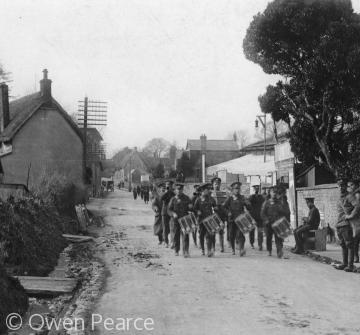The First World War
 Army drummers and buglers march along Codford High Street during the First World War
Army drummers and buglers march along Codford High Street during the First World WarThe First World War (known prior to the Second World War as The Great War) took place between 1914-1918 and was dubbed by many as 'the war to end all wars'. The war was triggered by the assasination of Archduke Franz Ferdinand, heir to the throne of Austria-Hungary, although other long-term political factors also played a role. The War involved most of the world's great powers and was ultimately fought between two sides, the Allies and the Central Powers. Millions of people died in the conflict, both military personnel and civilians.
The war had a significant impact on the English landscape. Troops were garrisoned across the countryside, with many camps sited in Salisbury Plain and its surrounding areas. 15 different camps were created in and around the Wiltshire village of Codford and used as a base for both military training and convalescence. Earthworks associated with the Codford Camp Railway, as well as surviving buildings and wooden huts can still be seen today.
ANZAC soldiers (members of the Australian and New Zealand Army Corps) formed the main element among the troops at Codford but some British soldiers were also stationed there, on their way to the front, including in January 1917 the poet Edward Thomas.
The church of Codford St Mary is the site of the UK's 2nd largest ANZAC cemetery (the largest is located in St Mary's, Harefield, West London). The cemetery is the final resting place for 31 Australian and 66 New Zealand soldiers, and holds an annual memorial event on the Sunday closest to ANZAC Day (25th April). ANZAC Day originally commemorated the Australian and New Zealand troops who died as part of the allied expedition at Gallipoli, Turkey during the First World War but has since become a commemoration of all ANZAC troops lost to conflict.
The Australian troops are also commemorated by the Lamb Down military cap badge, cut into the hillside just off the A36 by Australian troops stationed at the Codford and Sutton Veny military camps in 1916/17. Measuring approximately 175ft by 150ft, the badge is based on a the cap badge of the Australian Army, and named after the field in which it is carved. Covered over during WW2, the chalk badge is now regularly maintained by the local community in honour of those who gave their lives.
The First World War officially ended at 11am on 11 November 1918 and is commemorated annually on Armistice Day (also known as Rememberance Day).





